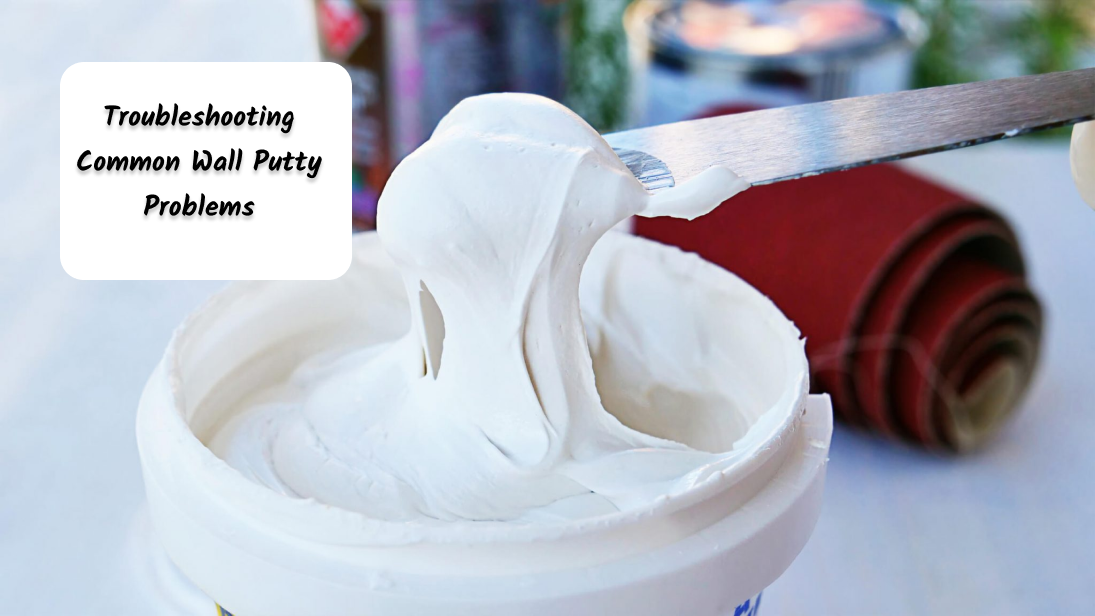Troubleshooting Common Wall Putty Problems

Wall putty is a product that holds pivotal importance during construction or renovation. Using this product enables construction professionals and homeowners to improve the aesthetic value of walls and surfaces. Moreover, wall putty provides the needed endurance to walls and makes them resistant to molds and other factors that damage the wall’s integrity.
Using the wall putty efficiently requires high-end proficiency. The lack of skills makes newbies to the construction industry and non-professionals susceptible to some general mistakes that may create issues like blistering, cracking the surface layer, and peeling off. In this blog, we will discuss various things about the best waterproof putty and the best ways to avoid mistakes that deliver unfavorable outcomes regarding wall putty.
Wall Putty: Overview
Wall putty is a heterogeneous conglomeration of white powder and premium-quality polymers. One can use these multiple surfaces and walls, such as rendered walls, precast walls, aerated lightweight blocks, concrete, etc. Moreover, these are ideal products for application on walls with damage or holes. The wall putty’s application facilitates an even finish to the walls and surfaces. The general practice is to apply these before walls receive final coloring. The following are two types of wall putties generally available in the market:-
Acrylic Wall Putty: These wall putties are available as a paste, and one can directly apply these on walls. Acrylic wall putties are water-based, and acrylic binders are the underlying materials, providing them with an alkali-resistant undercoat.
Cement-Based Wall Putty: These are available in the form of powder and require water action before they are applied. Cement-based wall putties are suitable for both internal and waterproof exterior wall putty.
Significance of Wall Putty in Construction and Renovation
The following are the applications of water resistant putty that make them a product of pivotal importance in establishing a new structure or its repurposing:-
Repairing Walls: Putty is an ideal material for filling up the cracks and damages in the wall. With the same, the integrity of walls remains protected, and they are less susceptible to external and internal damage.
Creating a Base for Paint: The base coat created with wall putty provides an even finish and provides a smooth foundation for paint coverage.
Insulation: The insulation provided for cracks and holes in walls using wall putty decreases the susceptibility to mold formation or any anomaly that may damage the wall’s internal components.
Moisture Resistance: Places in homes like kitchens and washrooms have a constant presence of moisture. Wall putty is an ideal material for those places and provides the most suitable base that resists misgivings of moisture content and prevents the walls from peel-offs and cracks.
Best Practices for Wall Putty Application
The following are the best ways to use the wall putty correctly:-
1) Sanding the surface creates a suitable base and increases the adhesiveness between the wall and the putty applied to it.
2) Cracks and holes must be freed from dust and debris before wall putty is applied to do the filling.
3) A person applying the wall putty should apply it in one corner and make the way out to avoid bubbles and wrinkles.
4) The use of a trowel or spatula eradicates lumps or bumps and enables the person to spread the waterproof wall care putty evenly.
5) The putty applied on the wall should be kept dry for 24 hours for another application.
Most Common Issues While Handing Wall Putty and Their Solutions
The following are some of the issues one faces while using wall putty, along with their solutions:-
Surface Should Have Appropriate Moisture Content to Avoid Chalking: If a surface is too dry or too wet, it causes chalking and powdering off. Adequate moisture content is necessary on walls while using the wall putty. Constructing in an appropriate environment enables the person to reduce the balance of the additional moisture content, causing issues. Moreover, to counter the reduced moisture abundance on walls, one can spray water and wait for some time before applying the wall putty.
An Open Slurry Causes Surface Crusting: A prolonged exposure to a slurry surface leads to a crust formation. Insulation prevents any unintended reaction from taking place and prevents the consistency of slurry.
Additional Latex Use: When the wall putty is applied over a wood plank, peeling off is likely to take place. Additional use of latex prevents the peeling off and protects the wall’s integrity.
Bubble Formation While Constructing Damp Base Surface: When the interior humidity of the wall is higher than the external humidity, bubbles form when putty is applied. The wall should be checked with thin damping and compaction for further putty application.
Also Know: Get the Best Quality Wall Putty for a Perfect Finish
Concluding Remarks!
Wall putty is a viable product for providing walls with an evenness and robust foundation for painting. With appropriate practices, one can have the best results for the issues one faces while using wall putty for distinct reasons. If you are looking for the best waterproof putty, Trimurti is the best brand for you. Visit our website for more information or contact us today.



